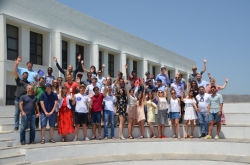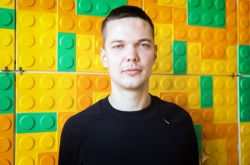The Russian pavilion at the biennale is dedicated to the past, present and future of railroads, which reflects the exhibition general topic "Freespace", as it is the railroads that make it possible to travel across Russia's vast territory.
The Olympic Park railway station (renamed to Imeretinsky Kurort railway station in 2015-- Ed.) is Russia's youngest major railway station. With an overall area of 30,000 square meters, the facility can boast the capаcity reaching up to 8,500 people per hour and enough space for gathering 3,000 passengers indoors. During the Olympiad, it successfully received passenger trains with fans that arrived approximately every 15 minutes. In order to prevent holdups, the designers followed the concept of expanding space at turns so as to prevent excessive accumulation of passengers on platforms.

"When getting ready for the exhibition, we wanted to visualize the dynamics of passenger flows at the railroad station in order to support the hypotheses that we've used for the building's design, but we didn't know where to go to with this idea, comments Ivan Kojin, Studio44's representative and the project's producer. Still, after we stumbled upon a video of an evacuation model of visitors of the Saint Petersburg Stadium, we realized that we wouldn't have to search anywhere far: we have everything we need here in St. Petersburg, at ITMO University. We already had coarse passenger flow computations that were enough on the design stage, but still insufficient for dynamic visualization. We wanted ITMO specialists to create a high-precision realistic model so that they could confirm or belie the feasibility of our solutions, and then visualize passenger flows in a way that would comply with the exposition's visual style.
Thanks to such modeling instruments, it becomes possible to conduct preliminary analysis of how particular architectural elements affect the logistics inside buildings. For instance, you can learn that by making some angle round, you decrease the time necessary for going from one side of the building to another by one to five minutes. Also, this project showed us how well programmers collaborate with architects on common tasks. We already have ideas on applying modeling in a relevant project on constructing the new Defense and Siege of Leningrad museum and exhibition complex."
A construction 3d model of the railway station has already been prepared at the design stage. The goal of specialists from the High-Performance Computing Department was to visualize the passenger flows and use computer models in order to test the hypothesis that the architectural concept of the station had been build upon.
"Our model showed what the maximum crowd density during rush hours can be, and how much time it takes for passengers to exit the railway station after they've left the train. The scenario of the dynamic of the passenger flow at Olympic Park has a lot in similar with that of our visitor evacuation model: in both cases, lots of people have to quickly and safely leave the building without forming many holdups," explains Andrei Karsakov, senior tutor at the High-Performance Computing Department and the project's supervisor.
He adds that for the development of the complex model of the transfer hub’s passenger flows, they've used a combination of both "serious" modeling environments and modern instrumentation used in game development. For the project's AI, ITMO specialists used the Menge modular framework which provided for low-level navigation and object avoidance. The more advanced behavioral model, as well as the model of traffic were developed by ITMO students in Unreal Engine 4 game engine.
What's interesting is that from the very start, the project implied the involvement of students in its development - a student from Moscow Architectural Institute from the customer's side, and students Andrei Simonov and Kirill Golubev from the Videogames’ Technologies program of the High-Performance Computing Department from ITMOs side.

"The focus of my research is AI for non-player characters, i.e. the characters that populate the game making the virtual world more alive. These behavioral modeling technologies have a wide range of applications, not only in game development but also in any field where you have to study and forecast the movement of people flows in a most realistic manner. Thanks to this project, I got an opportunity to test the ideas I work on as part of my research during the first year of my Master's program," says Andrei Simonov.
The student will expand on ways to applying Unreal Engine 4 technologies in crowd simulation, making nice-looking visuals, satisfying customers and going all the way to successfully completing a project while still being a student on June 23 at the meet-up of St. Petersburg's community of Unreal Engine 4 developers. You can check the full list of speakers and register for the event here.





